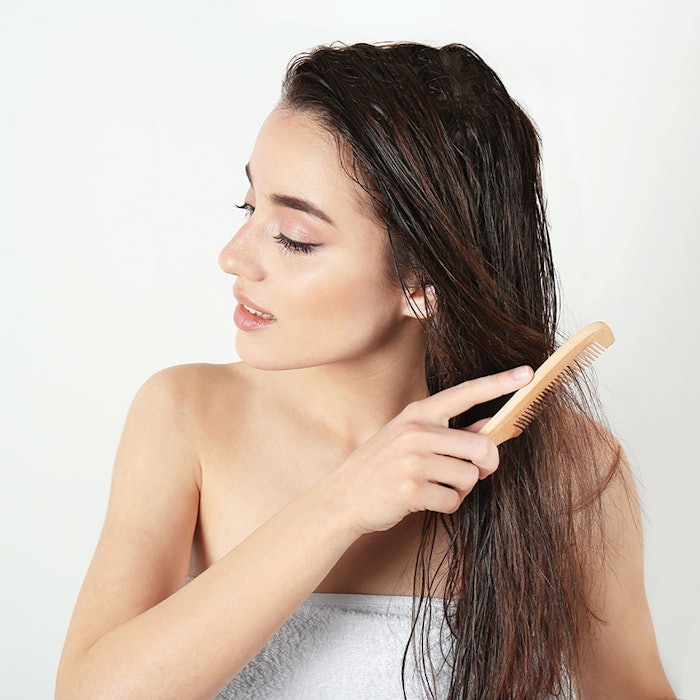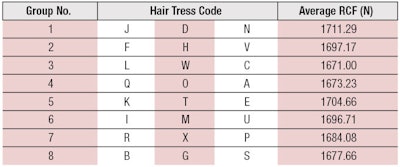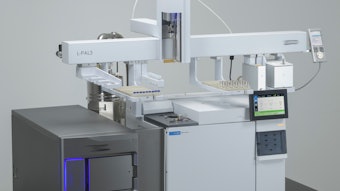
Hair cleansing and conditioning—i.e., removing contaminants and making it smooth, slippery and easy to comb—are fundamental consumer expectations. Shampoos mainly are designed for cleansing the hair and scalp; however, since the first two-in-one conditioning shampoo was introduced to the market 30 years ago, cleansing with a conditioned feel has become a basic requirement. On the other hand, in most cases, conditioners are designed with the sole purpose to condition hair.1, 2
The conditioning performance of a shampoo or conditioner is usually characterized by measuring the force required to comb hair tresses treated with it. This force can be measured using a combing tester,3, 4 performed on wet or dry hair tresses, and giving either wet combing force or dry combing force results. This typical approach has been used worldwide for decades to determine how well a shampoo or conditioner conditions hair.
However, such a measurement captures only a single point in time, i.e., the end or result, and not what happens throughout the washing or conditioning process. To examine these dynamics, a successive combing force devicea was developed to assess hair smoothness throughout the process. This enables holistic measurements, for example, during application and rinsing of the product. The feeling of conditioned hair throughout the process is an important signal (or bias) to consumers, so the ability to measure conditioning signals during use of the product is a powerful tool to aide product design and improve user satisfaction. In the present work, the device was put to the test to explore the effects of shampoos comprising various silicone and coacervate levels.
Test Set-up and Preparation
Combing tester components: The combing device consists of several parts, including a combing machine, control device, data processing unit, compressor and water heater. The combing machine is equipped with two shower heads; two combing arms—to which brushes are connected vertically to a potential displacement meter, hereinafter referred as the arms; and a hair tress holder connected to a load cell (see Figure 1).
Mode of action: The two combing arms are driven by compressed air, which strike horizontally to hold a hair tress between the brushes, then strike vertically by a high-precision servomotor to comb through the hair tress. The vertical displacement of the arms and the load on the hair tress holder during combing—i.e., the required combing force (RCF)—are recorded every 10 milliseconds (see Figure 2). The dynamic combing tester also measures hair static electricity values whilst measuring the combing force since less static after dry combing is an indication of good conditioning; as it is essentially equal to lower surface friction. Note that for most tests differences in static were insignificant, and therefore not pursued in the present work.
Hair tress samples: The hair tresses used for the present study were collected from Asian women and showed no signs of chemical damageb. They measured approximately 20 cm in length, 5.5 cm in width and 16.0 g in weight.
Hair tress standardization: The hair tresses were washed with a cleansing shampoo before use and measured with a combing tester to determine their RCF values. This confirmed the tresses were clean and their RCF values before treatment did not vary widely. Note that hereinafter, the RCF value before use will be referred to as the wet baseline. Researchers used 24 hair tresses per test, divided into eight groups of three tresses each, for statistical analysis.
The cleanness and homogeneity criteria standards required: an average wet baseline RCF value for all 24 samples within a +10% difference vs. the previous test’s wet baseline RCF value; and the relative standard deviation (RSD) for all 24 tresses and for three samples in one group within 10%. Table 1 and Table 2 show examples of baseline data and hair tress groupings based on the data. While measuring the effects of one shampoo sample, each group of tresses was tested in triplicate.
Silicone-containing shampoo showed lower combing force during the second-half rinsing, after-rinsing and dry-hair stages but not during lathering or first-half rinsing.
Test Protocol
The combing force protocol to assess the test shampoos consisted of:
1) Setting a hair tress on the holder;
2) Applying a warm water shower 40°C (± 5°C) at a flow rate of 70 mL/sec (±1 mL/sec) to the tress from both shower heads for 15 sec;
3) Combing the tress with the arms five times while applying the warm water shower (see Figure 2a);
4) Applying 1.5 mL of the test product on both sides of the tress with a syringe;
5) Spreading the test sample from root to tip on the tress by clamping the tress between the operator’s gloved palms (see Figure 2c);
6) Combing the tress with the arms five times without showering it (see Figure 2b);
7) Combing the tress with the arms 10 times while applying the warm water;
8) Combing the tress with the arms five times without showering;
9) Drying the tress for 24 hr and measuring its dry combing force value the next day (by combing the tress with the arms four times without showering); and
10) Collecting all the raw data obtained, converting this data to a required combing force index against an internal standard, then generating a graph (see Figure 3 and Figure 4 for examples).
Conditioning Tests and Results
Test formulas: To assess the capability of the device to measure conditioning performance, a pair of test shampoos was developed differing only in their silicone content (see Formula 1): the cleansing shampoo was silicone-free and the conditioning shampoo contained 2% dimethicone. Tests initially were conducted with these two product samples.
Figure 3 shows the results obtained. As the data shows, the silicone-containing shampoo showed significantly lower combing force than the cleansing shampoo during the second-half rinsing stage, the after-rinsing stage and the dried-hair stage. This indicated the silicone in the conditioning shampoo deposited onto hair to provide a lubrication benefit to the surface, which is consistent with previous findings.5, 6 Similar observations were obtained for hair conditioners with differing levels of silicones (data not shown).7, 8 Overall, these outcomes provided good indication that the dynamic combing test method was working effectively.
In addition, Figure 3 showed no significant combing force difference between the cleansing shampoo and conditioning shampoo during the lathering and first-half rinsing stages. This is not unexpected, as the two shampoos only varied in silicone content, which primarily is a conditioning agent for dried hair, as illustrated in Figure 4.1, 2
The feeling of conditioned hair throughout washing is an important signal to consumers.
Coacervation Tests and Results
It is well-known that conditioning performance in wet hair is predominately controlled by the coacervation of anionic surfactants and cationic polymers—such as cellulose or guar—in shampoos.1, 2 Thus, to further clarify the impact of coacervation on combing force in wet hair, three transparent shampoos were formulated (samples A, B and C) using different surfactant systems that show different coacervation behaviors.
It also is well-known that the coacervate formed during shampoo dilution can be characterized by measuring the transmittance of the diluted shampoo samples at a 600 nm wavelength; a lower transmittance indicates more coacervation. Thus, the transmittance values at a 1:10 dilution ratio for the three shampoo samples were as follows: shampoo A = 55% (highest coacervation); shampoo B = 71% (intermediate coacervation); and shampoo C = 93% (lowest coacervation). The related combing force results for these shampoos are shown in Figure 5.
Shampoo A required significantly lower combing force than shampoos B or C during lathering and rinsing stages. During rinsing, shampoo B required a lower combing force than shampoo C. At the after-rinsing and dried-hair stages, no significant difference was observed between the three shampoos.
This demonstrates a positive relationship between shampoo coacervation and combability improvement. Similar to cushion, the coacervation formed provided smoothness during application and rinsing, and protected wet hair from being damaged, as illustrated in Figure 6.1, 2 This provided further evidence that the dynamic combing test method was effective.
Additional case studies (data not shown) have been made comparing marketed shampoos, and these and reveal some variations in the combing force profiles obtained during earlier vs. later application stages. As such, it is important to measure the combing force successively, so as to avoid misleading results. This new device appears particularly suited
for this.
Conclusions
Based on these results, the authors conclude successive combing force measurements are effective for dynamically evaluating the hair conditioning performance of shampoos and conditioners. This approach more realistically simulates the entire process of shampooing and conditioning. By leveraging such a tool, product developers can assess hair washing and conditioning in a much more specified manner, which will assist them in selecting the right technical approach for each stage. In the end, this supports the more effective and efficient development of superior products.
References
- JZ Yang, Cosmetic science and technology, ch 36, in Hair Care Cosmetics, Elsevier, Amsterdam (2016) pp 601-617
- JZ Yang, Aesthetic Dermatology: IV. Shampoo and Conditioner, 2nd edn, Nanzando, Tokyo (2009) pp 380-385
- R Suzuki, I Iida and T Someya, Study on the evaluation method for the combing force of human hair, J Soc Cosmet Chem Japan 33(3) 238-244 (1999)
- TA Evans, Evaluating hair conditioning with instrumental combing, Cosm & Toil 126(8) 558-563 (2011)
- Q Huang, ZW Mei, K Takata and JZ Yang, Analyzing deposition from rinse-off hair products, Cosm & Toil 128(11) 810-815 (2013)
- C LaTorre, B Bhushan, JZ Yang and PM Torgerson, Nanotribological effects of silicone type and deposition level and surfactant type on human hair using atomic force microscopy, J Cosmet Sci 57(37) (2006)
- E Yamasaki, S Ito and JZ Yang, Technologies for silicone-free hair care products, Fine Chemical 45(1) 6 (2016)
- E Yamasaki, X Lin and JZ Yang, Development of sulfate-free shampoo, Fine Chemical 45(1) 12 (2016)













